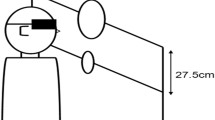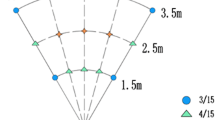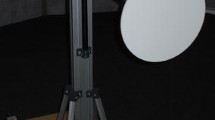Abstract
The ability of humans to echolocate has been recognized since the 1940s. Little is known about what determines individual differences in echolocation ability, however. Although hearing ability has been suggested as an important factor in blind people and sighted-trained echolocators, there is evidence to suggest that this may not be the case for sighted novices. Therefore, non-auditory aspects of human cognition might be relevant. Previous brain imaging studies have shown activation of the early ‘visual’, i.e. calcarine, cortex during echolocation in blind echolocation experts, and also during visual imagery in blind and sighted people. Therefore, here we investigated the relationship between echolocation ability and vividness of visual imagery (VVI). Twenty-four sighted echolocation novices completed Marks’ (Br J Psychol 1:17–24, 1973) VVI questionnaire and they also performed an echolocation size-discrimination task. Furthermore, they participated in a battery of auditory tests that determined their ability to detect fluctuations in sound frequency and intensity, as well as hearing differences between the right and left ear. A correlational analysis revealed a significant relationship between participants’ VVI and echolocation ability, i.e. participants with stronger VVI also had higher echolocation ability, even when differences in auditory abilities were taken into account. In terms of underlying mechanisms, we suggest that either the use of visual imagery is a strategy for echolocation, or that visual imagery and echolocation both depend on the ability to recruit calcarine cortex for cognitive tasks that do not rely on retinal input.



Similar content being viewed by others
References
Ammons CH, Worchel P, Dallenbach KM (1953) “Facial vision”: the perception of obstacles out of doors by blindfolded and blindfolded-deafened subjects. Am J Psychol 56(4):519–553
Ashmead D, Hill E, Talor C (1989) Obstacle perception by congenitally blind children. Percept Psychophys 46:425–433
Ashmead DH, Wall RS, Eaton SB, Ebinger KA, Snook-Hill MM, Guth DA, Yang X (1998) Echolocation reconsidered: using spatial variations in the ambient sound field to guide locomotion. J Vis Impair Blind 92:615–632
Bavelier D, Neville H (2002) Cross-modal plasticity: where and how? Nat Rev Neurosci 3:443–452
Brainard DH (1997) The psychophysics toolbox. Spat Vis 10:433–436
Büchel C, Price C, Frackowiak RS, Friston K (1998) Different activation patterns in the visual cortex of late and congenitally blind subjects. Brain 121:409–419
Carlson-Smith C, Wiener WR (1996) The auditory skills necessary for echolocation: a new explanation. J Vis Impair Blind 90:21–35
Cattaneo Z, Vecchi T, Cornoldi C, Mammarella I, Bonino D, Ricciardi E, Pietrini P (2008) Imagery and spatial processes in blindness and visual impairment. Neurosci Biobehav Rev 32(8):1346–1360
Cohen LG, Celnik P, Pascual-Leone A, Corwell B, Faiz L, Dambrosia J, Honda M, Sadato N, Gerloff C, Catala′ MD, Hallett M (1997) Functional relevance of cross-modal plasticity in blind humans. Nature 389:180–183
Cohen LG, Weeks RA, Sadato N, Celnik P, Ishii K, Hallett M (1999) Period of susceptibility for cross-modal plasticity in the blind. Ann Neurol 45(4):451–460
Cotzin M, Dallenbach KM (1950) Facial vision: the role of pitch and loudness in the perception of obstacles by the blind. Am J Psychol 63:485–515
Cui X, Jeter CB, Yang D, Montague PR, Eagleman DM (2007) Vividness of mental imagery: individual variability can be measured objectively. Vis Res 47:474–478
Dufour A, Després O, Candas V (2005) Enhanced sensitivity to echo cues in blind subjects. Exp Brain Res 165:515–519
Dulin D, Hatwell Y, Pylyshyn Z, Chokron S (2008) Effects of peripheral and central visual impairment on mental imagery capacity. Neurosci Biobehav Rev 32:1396–1408
Griffin DR (1944) Echolocation in blind men, bats and radar. Science 100:589–590
Kaski D (2002) Revision: is visual perception a requisite for visual imagery? Perception 31(6):717–732
Keogh R, Pearson J (2011) Mental imagery and visual working memory. PLoS ONE 6:e29221. doi:10.1371/journal.pone.0029221
Kerr NH (1983) The role of vision in “visual imagery” experiments: evidence from the congenitally blind. J Exp Psychol Gen 112(2):265–277
Kolarik AJ, Cirstea S, Pardhan S (2013) Evidence for enhanced discrimination of virtual auditory distance among blind listeners using level and direct-to-reverberant cues. Exp Brain Res 224:623–633
Kosslyn SM, Thompson WL (2003) When is early visual cortex activated during visual mental imagery? Psychol Bull 129:723–746
Kosslyn SM, Ganis G, Thompson WL (2001) Neural foundations of imagery. Nat Rev Neurosci 2(9):635–642
Lambert S, Sampaio E, Mauss Y, Scheiber C (2004) Blindness and brain plasticity: contribution of mental imagery? An fMRI study. Cog Brain Res 20(1):1–11
Marks DF (1973) Visual imagery differences in the recall of pictures. Br J Psychol 1:17–24
Merabet LB, Pascual-Leone A (2010) Neural reorganization following sensory loss: the opportunity of change. Nat Rev Neurosci 11:44–52
Papadopoulos T, Edwards DS, Rowan D, Allen R (2011) Identification of auditory cues utilized in human echolocation—objective measurement results. Biomed Signal Process 6:280–290
Pascual-Leone A, Hamilton R (2001) The metamodal organization of the brain. Prog Brain Res 134:427–445
Rademaker RL, Pearson J (2012) Training visual imagery. Improvements of metacognition but not imagery strength. Front Psychol 3:1–11. doi:10.3389/fpsyg.2012.00224
Roeser RJ, Clark JL (2007) Pure tone tests. In: Roeser R, Valente M, Hosford-Dunn H (eds) Audiology: diagnosis, 2nd edn. Thieme Medical Publishers, New York, pp 238–260
Rojas JAM, Hermosilla JA, Montero RS, Espi PLL (2009) Physical analysis of several organic signals for human echolocation: oral vacuum pulses. Acta Acust United Acust 95:325–330
Rosenblum LD, Gordon MS, Jarquin L (2000) Echolocating distance by moving and stationary listeners. Ecol Psychol 12(3):181–206
Sadato N, Okada T, Honda M, Yonekura Y (2002) Critical period for cross-modal plasticity in blind humans: a functional MRI study. Neuroimage 16:389–400
Schenkman BN, Nilsson ME (2010) Human echolocation: blind and sighted persons’ ability to detect sounds recorded in the presence of a reflecting object. Perception 39:483–501
Schenkman BN, Nilsson ME (2011) Human echolocation: pitch versus loudness information. Perception 40:840–852
Sherwood R, Pearson J (2010) Closing the mind’s eye: incoming luminance signals disrupt visual imagery. PLoS ONE 5:e15217. doi:10.1371/journal.pone.0015217
Stoffregen TA, Pittenger JB (1995) Human echolocation as a basic form of perception and action. Ecol Psychol 7:181–216
Supa M, Cotzin M, Dallenbach KM (1944) Facial vision: the perception of obstacles by the blind. Am J Psychol 57:133–183
Teng S, Whitney D (2011) The acuity of echolocation: spatial resolution in sighted person compared to the performance of an expert who is blind. J Vis Impair Blind 105:20–32
Teng S, Puri A, Whitney D (2012) Ultrafine spatial acuity of blind expert human echolocators. Exp Brain Res 216:483–484
Thaler L (2013) Echolocation may have real-life advantages for blind people: an analysis of survey data. Front Integr Physiol 4:98. doi:10.3389/fphys.2013.00098
Thaler L, Arnott SR, Goodale MA (2011) Neural correlates of natural human echolocation in early and late blind echolocation experts. PLoS ONE 6:e20162. doi:10.1371/journal.pone.0020162
Thaler L, Milne JL, Arnott SR, Kish D, Goodale MA (2013) Neural correlates of motion processing through echolocation, source hearing and vision in blind echolocation experts and sighted echolocation novices. J Neurophys. doi:10.1152/jn.00501.2013
Worchel P, Dallenbach KM (1947) Facial vision: perception of obstacles by the deaf-blind. Am J Psychol 60:502–553
Worchel P, Mauney J (1951) The effect of practice on the perception of obstacles by the blind. J Exp Psychol 41:170–176
Zimler J, Keenan JM (1983) Imagery in the congenitally blind: how visual are visual images? J Exp Psychol Learn 9(2):269–282
Acknowledgments
We thank Markus Hausmann, Mary-Ellen Large, Santani Teng, and two anonymous reviewers for commenting on a previous draft of this manuscript.
Author information
Authors and Affiliations
Corresponding author
Additional information
Rosanna C. Wilson and Bethany K. Gee have contributed equally to the work.
Electronic supplementary material
Below is the link to the electronic supplementary material.
Rights and permissions
About this article
Cite this article
Thaler, L., Wilson, R.C. & Gee, B.K. Correlation between vividness of visual imagery and echolocation ability in sighted, echo-naïve people. Exp Brain Res 232, 1915–1925 (2014). https://doi.org/10.1007/s00221-014-3883-3
Received:
Accepted:
Published:
Issue Date:
DOI: https://doi.org/10.1007/s00221-014-3883-3




